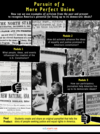
Students analyze James Madison’s notes to understand why delegates at the Constitutional Convention in 1787 compromised on equality in order to form a United States government, what steps they later took to create a Bill of Rights, and whose rights were protected and whose were not. Students learn about key efforts to uphold the rights of people in the United States, from the Constitutional Convention in 1787 to examples of participatory journalism today in order to respond to the question: How can we use examples of activism from the past and present to recognize America’s potential for living up to its democratic ideals? Students then analyze artifacts from the Colored Conventions, which was one of the first Black political intellectual movements in the United States to advocate for the rights of people who have been marginalized. Students create an original political pamphlet to raise awareness and inspire action on issues of injustice and inequality today.
- Subject:
- U.S. History
- Material Type:
- Lesson
- Lesson Plan
- Module
- Teaching/Learning Strategy
- Unit of Study
- Author:
- Educurious .
- Date Added:
- 05/04/2022
